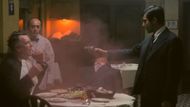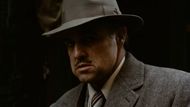Francis Ford Coppola's The Godfather is one of the biggest cinematic masterpieces Hollywood has ever produced, thanks to a great ensemble and a genius story with storytelling. The three-part franchise has been an exemplary piece of gangster drama, blurring the lines between loyalty and betrayal, family and crime, and power and vulnerability. At the center of The Godfather lies not just the legacy of the Corleone family’s rise and fall, but a stark contrast of the American Dream itself—how ambition, when laced with violence and inherited legacy, does not always end well and good.
Apart from the grandeur, the film is full of iconic scenes, and cinephiles are often coming out with newer theories and reasoning behind pivotal parts of the film. One such scene is Michael's restaurant shooting scene. The restaurant shooting scene in The Godfather is one of the most pivotal moments in the trilogy. It marks the turning point where Michael Corleone, once an outsider to the family's criminal empire, steps into the shadows of his father's legacy.
The scene carries the weight of a man crossing a moral threshold he can never return from. It marks a moment of metamorphosis for Michael. What makes it even more striking is the quiet defiance in Michael’s actions—his choice to move at his own pace, to hold onto the gun longer than instructed, and to think rather than react. Here's why Michael from The Godfather does not follow Clemenza’s orders during the infamous restaurant shooting sequence and what it means for the film.
What is the restaurant shooting sequence?

Michael Corleone, played by Al Pacino, is the heart of this scene that goes on to become one of the most pivotal moments in the film. Vito's youngest son, he's portrayed as the 'good son' and is often seen as an outsider to his family's criminal motives because of this goodness. As someone who has served in the U.S. military, he is kept away from all the blood, violence, and crime his family operated on. Initially he himself stays away from all the mafia and crime around him but eventually becomes one of the most ruthless heads of the Corleone family.
The scene succeeds an assassination attempt on Michael's father, where he volunteers to kill the drug lord Sollozzo and McCuluskey, a corrupt police officer. The scene is seen as his transformation, as he has never partaken in any violence before. It's his big chance. That one moment where he finally crosses the bridge and joins his family.
He is informed earlier on that a gun will be hidden in the bathroom and that he has to go and get the gun, come back, and shoot them. Michael does exactly that. In a vicious way he shoots both the men as the restaurant becomes a bloody mess. It's a crucial scene because it establishes him in his family as no longer being an outsider.
What is Clemenza's advice about the restaurant's shooting? Does Michael follow it?
Clemenza, Vito Corleone's friend, advises Michael to go and get the gun and then come out blasting it while killing both the men. In contrast, Michael does not do that. He gets the gun and comes out quietly and sits down again. He tunes out Sollozzo's conversation and contemplates his actions that will occur soon.
His killing is less volatile and more strategic. He does not follow Clemenza's advice and does the rather opposite.
Even before that, he tries out ways to avoid the murders. He reasons with both the men and asks them for his father's safety. He tries to make a deal and attempts to not commit the crime he's there to commit. In short, he tries his best to spare both of them.
Even after he gets the gun from the bathroom, he remains uncomfortable. As someone who has never killed anyone before, Michael shifts uncomfortably and contemplates what he is about to do. The scene proves how it was not easy for him to leave behind his values and morals to join his family's legacy. It's a moment where he's trying to make the choice of either being the outcast with morals or joining his family in the violence. Needless to say, he chooses the latter and becomes the most skilled gangster in the Corleone family.
Why The Godfather remains an eternal classic

Needless to say, The Godfather trilogy is some of Coppola's best work and will continue to be a massive legacy in the history of cinema. Laced with passion, intricate details, and just the right amount of violence, the film is a treat to the eyes as you explore the American mafia scene through the lens of the Corleone family and their insider politics. With a stunning cast, mind-blowing visuals, and a soundtrack that gives you chills, the Godfather trilogy had all the perfect ingredients for a masterpiece.
The film starred Marlon Brando as Vito Corleone, the patriarch of the Corleone family, and Al Pacino as Michael Corleone, his youngest son. James Caan plays Sonny Corleone, Vito’s eldest son, while Richard Castellano appears as Peter Clemenza, a caporegime in the Corleone family and Sonny’s godfather. Robert Duvall portrays Tom Hagen, the family’s consigliere and adopted son. Sterling Hayden plays Captain McCluskey, a corrupt police officer on Sollozzo’s payroll. John Marley appears as Jack Woltz, a Hollywood film producer, and Richard Conte plays Emilio Barzini, a rival crime boss.
Released in 1972, it was the highest-grossing film ever made till then and became a benchmark for great cinematic endeavor while being regarded widely as one of the most influential films of the gangster genre. The project started off rather difficultly, with its rights being sold for just $80,000 to Paramount. It soon shot to fame and became the phenomenon it is now.
The franchise is inspired by Mario Puzo's novel of the same name and spanned across three films.
The Godfather trilogy is available to stream on Prime Video.
Love movies? Try our Box Office Game and Movie Grid Game to test your film knowledge and have some fun!
